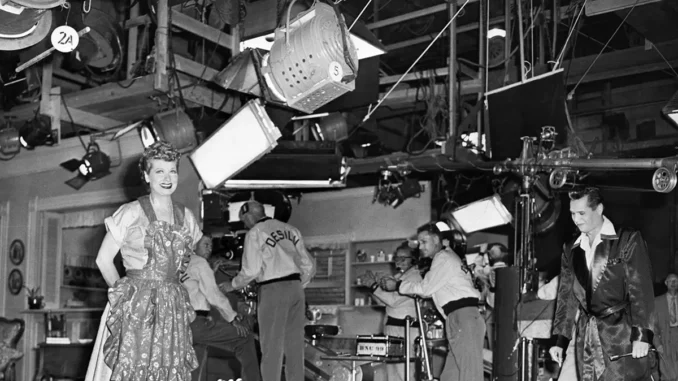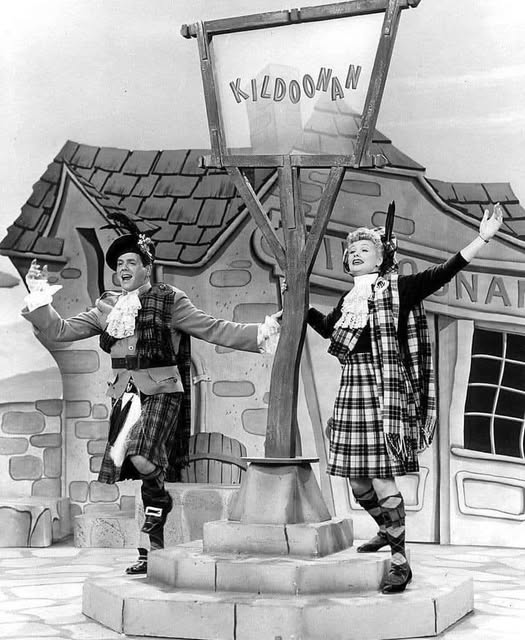
More than seventy years after I Love Lucy first aired in 1951, America’s most iconic sitcom continues to charm audiences around the world. It wasn’t just a comedy — it was a revolution, reshaping television storytelling, production methods, and even celebrity culture. But beyond the scripted chaos of Lucy and Ricky Ricardo’s marriage, an entire world thrived behind the camera: one filled with innovation, improvisation, and deep friendship.
Now, a newly curated collection of 25 never-before-seen behind-the-scenes photos offers a rare window into that world. Sourced from CBS archives, personal estates, and private collectors, these images remind us why I Love Lucy remains not just beloved, but historic.
Innovation in Every Frame
One of the earliest photos in the collection shows Lucille Ball and Desi Arnaz reviewing film reels with cinematographer Karl Freund, a German émigré whose technical genius helped redefine TV lighting. Freund, who once worked with Fritz Lang and F.W. Murnau, brought cinematic depth to sitcom television. His three-camera setup — developed for I Love Lucy — became the gold standard for multi-camera production, still used today in shows like Friends and The Big Bang Theory.
In this photo, Lucy’s expression says it all: part curiosity, part command. She wasn’t just the star; she was an architect of television as we know it.
A Marriage on and off the Screen
Other candid moments show the chemistry that powered the series — and occasionally strained it. One image captures Lucy and Desi laughing between takes, his arm around her shoulder as the audience waits. Their relationship, both deeply romantic and volatile, became the emotional backbone of I Love Lucy. What fans didn’t see were the long nights of tension and reconciliation that followed after filming wrapped.
Historians often point out that I Love Lucy blurred the line between fiction and reality. Desi’s thick Cuban accent, Lucy’s fiery independence, and their comic misunderstandings were pulled straight from their real lives. These behind-the-scenes glimpses humanize that dynamic, showing two professionals trying to protect their marriage while reinventing television.
The Unsung Heroes of Laughter
One of the most striking images from the new collection shows Vivian Vance and William Frawley — Ethel and Fred Mertz — sharing coffee during rehearsal. The pair’s well-documented off-screen animosity is the stuff of legend, but in this photo, they seem relaxed, even amused. It’s a reminder that comedy, even when born of friction, can produce magic.
There’s also a photo of writer Madelyn Pugh Davis, one of the few women in 1950s television writing rooms, scribbling lines for Lucy’s latest scheme. Her contributions, along with those of writing partner Bob Carroll Jr., shaped I Love Lucy’s humor: physical, yes, but also emotionally intelligent. Without them, Lucy’s antics might have been slapstick; with them, they became universal.

The Power of a Live Audience
Another rare image reveals the live audience setup at Desilu Studios — the first sitcom to be filmed before a studio audience on 35mm film. Ball insisted on this hybrid approach, which allowed the show to feel both spontaneous and cinematic.
In one photo, audience members can be seen dabbing tears from laughter during the famous “Vitameatavegamin” episode. The laughter was real, not canned — a direct connection between performer and public that modern sitcoms still try to recreate.
Beyond the Laughter
These photographs also highlight how I Love Lucy challenged social norms. Lucy’s pregnancy arc in Season 2, for instance, was groundbreaking: no American sitcom had ever shown a pregnant woman on television, let alone used it as a central plotline. Ball’s real-life pregnancy was written into the show, forcing CBS executives to confront their own prudishness.
A particularly moving photo shows Lucy cradling baby Desi Jr. on set, smiling as crew members adjust lights around her. It’s a portrait of a working mother at a time when such an image was nearly unheard of on American TV.
A Legacy in Every Laugh
The cultural impact of I Love Lucy endures precisely because of moments like these — unscripted, authentic, and fearless. These 25 photos don’t just capture a show; they capture a transformation in American entertainment, one that turned a sitcom into an institution.
Even now, in an era of streaming algorithms and social media virality, I Love Lucy’s DNA can be found everywhere. Every time an audience laughs at a perfectly timed pratfall or a heartfelt confession disguised as comedy, Lucy’s legacy flickers to life again.
